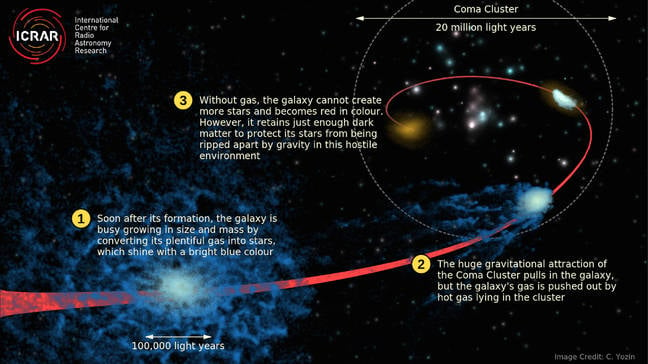This article is more than 1 year old
STARS SNUFFED in massive galactic whodunit
Coma Cluster's 'dead galaxies' are 99 per cent dark matter, boffin says
It's generally accepted by astronomers that dark matter makes up roughly 27 per cent of the known Universe – but in a galactic cluster 300 million light years away, that proportion is all skewiff.
Simulations carried out by ICRAR (International Centre for Radio Astronomy Research) doctoral student Cameron Yozin using big iron at Western Australia's Pawsey Centre have yielded a dark surprise: some galaxies sucked into what's called the Coma Cluster are as much as 99 per cent dark matter.
Astronomers' interest in the so-called “dark galaxies” was first piqued last year, when just 47 such galaxies were spotted in the cluster. As Astronomy Now reported at the end of June, surveys trawling archival data from the Subaru telescope upped the ante – and the mystery – considerably, with 800 such dark galaxies spotted in the cluster.
According to ICRAR's announcement, the Coma Cluster is one of the largest known structures in the universe.
The problem is that the extremely diffuse dark galaxies that have fallen into the cluster have to be held there by gravity, and analysis of the number of stars they contain doesn't yield enough visible matter to account for the mass they would need.

Why the dark galaxies are mostly dark matter. Click here to embiggen.
In the ICRAR announcement, Yozin says that the galaxies stopped forming stars when they fell into the cluster (between seven and ten billion years ago).
The immense gravity of the cluster stole the hydrogen and helium from the in-falling galaxies, leaving them nothing with which to make new stars. That left them with a footprint similar to the Milky Way, but only 1 percent as many stars.
There's only one problem with that scenario, though: why did the cluster steal the gases, but leave the already-extant stars in place?
That's where the dark matter hypothesis comes in: that stuff hung around with the in-falling galaxy, holding it together to leave the structures we can see today: “they fell in with enough dark matter to protect their visible matter”, Yozin says.
Yozin said the simulations used the GRAPE (Gravity Pipe) software by co-author Dr Kenji Bekki.
“GRAPE is specialised for the intense calculations of gravity interactions between stars and dark matter”, he said.
That, Yozin explained, allowed him to set the initial conditions for the work – the likely state of the Coma Cluster ten billion years ago, and the likely state of the dark galaxies before they fell into the cluster.
He told The Register the initial conditions for the dark galaxies are based on what's already been observed – their mass, size, gas content, and colour, which indicates how long it's been since they last formed stars.
There aren't too many other assumptions needed to start the simulation, Yozin told us: “we assume a spherically symmetric distribution of dark matter in the cluster, and the amount of hot gas we believe is in the cluster”.
Even with a supercomputer available, it's impossible to represent every star in every galaxy in the cluster. The current state of the art for such simulations represents up to ten million “particles”, Yozin told The Register, and his simulations used more than a million particles evolving over billions of years.
His paper is published in the Monthly Notices of the Royal Astronomical Society (abstract here). ®
